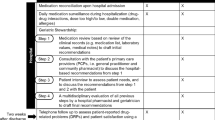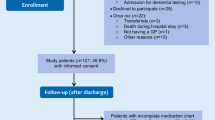Abstract
Objective
This study's objective was to determine whether patients treated in a geriatric evaluation and management unit (GEMU) had a more appropriate drug profile than patients treated in the general medical wards (MW).
Methods
Frail elderly patients admitted as emergencies to the medical department were randomised to treatment in the GEMU (n=127) or MW (n=127). Drugs used at inclusion and discharge were registered retrospectively and analysed with regard to polypharmacy, number of drugs withdrawn or started, potential drug-drug interactions (DDIs), number of anticholinergic drugs prescribed, and the number of inappropriate drug prescriptions according to Beers' criteria. Utilisation of psychotropic and cardiovascular drugs was compared in detail according to prespecified hypotheses.
Results
The number of patients with polypharmacy did not differ significantly between the GEMU and MW. The median number of scheduled drugs withdrawn per patient was higher in the GEMU than in the MW (p=0.005). Drugs with anticholinergic effects (p=0.003); cardiovascular drugs (p<0.001), particularly digitalis glycosides (p<0.001); and antipsychotic drugs (p=0.009) were withdrawn more often in the GEMU. The median number of scheduled drugs started was higher in the GEMU than in the MW (p=0.03). In particular, antidepressants (p<0.001) and estriol (p=0.001) were started more often in the GEMU than in the MW. Fewer GEMU than MW patients had potential DDIs at discharge (p=0.009).
Conclusion
Drug treatment in the GEMU as compared with the MW was more appropriate in terms of prescription of fewer drugs with anticholinergic effects and fewer potential DDIs. There were distinct differences in treatment patterns of cardiovascular and psychotropic drugs.
Similar content being viewed by others
References
Beers MH, Baran RW, Frenia K (2000) Drugs and the elderly, Part 1. The problems facing managed care. Am J Manag Care 6:1313–1320
Doucet J, Chassagne P, Trivalle C, Landrin I, Pauty MD, Kadri N, Merard JF, Bercoff E (1996) Drug-drug interactions related to hospital admissions in older adults: a prospective study of 1000 patients. J Am Geriatr Soc 44:944–948
Mannesse CK, Derkx FH, de Ridder MA, Man in 't Veld AJ, van der Cammen TJ (2000) Contribution of adverse drug reactions to hospital admission of older patients. Age Ageing 29:35–39
Pirmohamed M, James S, Meakin S, Green C, Scott AK, Walley TJ, Farvar K, Park BK, Breckenridge AM (2004) Adverse drug reactions as cause of admission to hospital: prospective analysis of 18,820 patients. Br Med J 329:15–19
Onder G, Pedone C, Landi F, Cesari M, Della VC, Bernabei R, Gambassi G (2002) Adverse drug reactions as cause of hospital admissions: results from the Italian Group of Pharmacoepidemiology in the Elderly (GIFA). J Am Geriatr Soc 50:1962–1968
Lazarou J, Pomeranz BH, Corey PN (1998) Incidence of adverse drug reactions in hospitalized patients: a meta–analysis of prospective studies. JAMA 279:1200–1205
Ebbesen J, Buajordet I, Erikssen J, Brors O, Hilberg T, Svaar H, Sandvik L (2001) Drug-related deaths in a department of internal medicine. Arch Intern Med 161:2317–2323
Aparasu RR, Mort JR (2000) Inappropriate prescribing for the elderly: Beers criteria-based review. Ann Pharmacother 34:338–346
Kohler GI, Bode–Boger SM, Busse R, Hoopmann M, Welte T, Boger RH (2000) Drug-drug interactions in medical patients: effects of in-hospital treatment and relation to multiple drug use. Int J Clin Pharmacol Ther 38:504–513
Seymour RM, Routledge PA (1998) Important drug-drug interactions in the elderly. Drugs Aging 12:485–494
Egger SS, Drewe J, Schlienger RG (2003) Potential drug-drug interactions in the medication of medical patients at hospital discharge. Eur J Clin Pharmacol 58:773–778
Mintzer J, Burns A (2000) Anticholinergic side-effects of drugs in elderly people. J R Soc Med 93:457–462
Moore AR, O'Keeffe ST (1999) Drug-induced cognitive impairment in the elderly. Drugs Aging 15:15–28
Han L, McCusker J, Cole M, Abrahamowicz M, Primeau F, Elie M (2001) Use of medications with anticholinergic effect predicts clinical severity of delirium symptoms in older medical inpatients. Arch Intern Med 161:1099–1105
Beers MH, Ouslander JG, Rollingher I, Reuben DB, Brooks J, Beck JC (1991) Explicit criteria for determining inappropriate medication use in nursing home residents. UCLA Division of Geriatric Medicine. Arch Intern Med 151:1825–1832
Beers MH (1997) Explicit criteria for determining potentially inappropriate medication use by the elderly. An update. Arch Intern Med 157:1531–1536
Fick DM, Cooper JW, Wade WE, Waller JL, Maclean JR, Beers MH (2003) Updating the Beers criteria for potentially inappropriate medication use in older adults: results of a US consensus panel of experts. Arch Intern Med 163:2716–2724
Onder G, Landi F, Cesari M, Gambassi G, Carbonin P, Bernabei R (2003) Inappropriate medication use among hospitalized older adults in Italy: results from the Italian Group of Pharmacoepidemiology in the Elderly. Eur J Clin Pharmacol 59:157–162
Fu AZ, Liu GG, Christensen DB (2004) Inappropriate medication use and health outcomes in the elderly. J Am Geriatr Soc 52:1934–1939
Gelenberg AJ, Katz MD (1993) Antipsychotic agents. In: Bressler R and Katz MD (eds) Geriatric pharmacology. McGraw–Hill, New York, pp 375–408
Ahmed A, Allman RM, DeLong JF (2002) Inappropriate use of digoxin in older hospitalized heart failure patients. J Gerontol A Biol Sci Med Sci 57:M138–M143
Kelly J, Chamber J (2000) Inappropriate use of loop diuretics in elderly patients. Age Ageing 29:489–493
Gurwitz JH (2004) Polypharmacy a new paradigm for quality drug therapy in the elderly? Arch Intern Med 164:1957–1959
Kennedy HL (2001) Current utilization trends for beta–blockers in cardiovascular disease. Am J Med 110(Suppl 5A):2S–6S
Kruse W, Rampmaier J, Frauenrath–Volkers C, Volkert D, Wankmuller I, Micol W, Oster P, Schlierf G (1991) Drug–prescribing patterns in old age. A study of the impact of hospitalization on drug prescriptions and follow-up survey in patients 75 years and older. Eur J Clin Pharmacol 41:441–447
Rubenstein LZ, Josephson KR, Wieland GD, English PA, Sayre JA, Kane RL (1984) Effectiveness of a geriatric evaluation unit. A randomized clinical trial. N Engl J Med 311:1664–1670
Owens NJ, Sherburne NJ, Silliman RA, Fretwell MD (1990) The Senior Care Study. The optimal use of medications in acutely ill older patients. J Am Geriatr Soc 38:1082–1087
Carbonin P, Pahor M, Bernabei R, Sgadari A (1991) Is age an independent risk factor of adverse drug reactions in hospitalized medical patients? J Am Geriatr Soc 39:1093–1099
Schmader KE, Hanlon JT, Pieper CF, Sloane R, Ruby CM, Twersky J, Francis SD, Branch LG, Lindblad CI, Artz M, Weinberger M, Feussner JR, Cohen JR (2004) Effects of geriatric evaluation and management on adverse drug reactions and suboptimal prescribing in the frail elderly. Am J Med 116:394–401
Counsell SR, Holder CM, Liebenauer LL, Palmer RM, Fortinsky RH, Kresevic DM, Quinn LM, Allen KR, Covinsky KE, Landefeld CS (2000) Effects of a multicomponent intervention on functional outcomes and process of care in hospitalized older patients: a randomized controlled trial of Acute Care for Elders (ACE) in a community hospital. J Am Geriatr Soc 48:1572–1581
Saltvedt I, Mo ES, Fayers P, Kaasa S, Sletvold O (2002) Reduced mortality in treating acutely sick, frail older patients in a geriatric evaluation and management unit. A prospective randomized trial. J Am Geriatr Soc 50:792–798
Saltvedt I, Saltnes T, Mo ES, Fayers P, Kaasa S, Sletvold O (2004) Acute geriatric intervention increases the number of patients able to live at home. A prospective randomized study. Aging Clin Exp Res 16:300–306
Beers MH, Jones TV, Berkwits M, Kapland J, Porter R (2005) The Merck Manual of Geriatrics, 3rd edn. Merck Shape & Dohme Research Laboratories http://www.merck.com/mrkshared/mmg/home.jsp
Winograd CH, Gerety MB, Chung M, Goldstein MK, Dominguez F, Jr., Vallone R (1991) Screening for frailty: criteria and predictors of outcomes. J Am Geriatr Soc 39:778–784
Inouye SK (2004) A practical program for preventing delirium in hospitalized elderly patients. Cleve Clin J Med 71:890–896
World Health Organization and Collaboration Center for Drugs Statistics Methodology (1998) Guidelines for Anatomical Therapeutic Chemical classification and defined daily dose assignment. World Health Organization, Geneva
Spigset O (ed) (1999) Norwegian Drug Information Database.http://www.interaksjoner.no
Hansten PD, Horn JR (2000) Drug interactions analysis and management. Applied Therapeutics, Vancouver, WA
Hanlon JT, Schmader KE, Samsa GP, Weinberger M, Uttech KM, Lewis IK, Cohen HJ, Feussner JR (1992) A method for assessing drug therapy appropriateness. J Clin Epidemiol 45:1045–1051
Batty GM, Grant RL, Aggarwal R, Lowe D, Potter JM, Pearson MG, Jackson SH (2003) Using prescribing indicators to measure the quality of prescribing to elderly medical in-patients. Age Ageing 32:292–298
Linjakumpu T, Hartikainen S, Klaukka T, Veijola J, Kivela SL, Isoaho R (2002) Use of medications and polypharmacy are increasing among the elderly. J Clin Epidemiol 55:809–817
Hanlon JT, Artz MB, Pieper CF, Lindblad CI, Sloane RJ, Ruby CM, Schmader KE (2004) Inappropriate medication use among frail elderly inpatients. Ann Pharmacother 38:9–14
Hajjar ER, Hanlon JT, Sloane RJ, Lindblad CI, Pieper CF, Ruby CM, Branch LC, Schmader KE (2005) Unnecessary drug use in frail older people at hospital discharge. J Am Geriatr Soc 53:1518–1523
Osterweil D, Brummel Smith K, Beck JC (2000) Comprehensive geriatric assessment. New York, McGraw–Hill, New York
Gurwitz JH, Rochon P (2002) Improving the quality of medication use in elderly patients: a not–so–simple prescription. Arch Intern Med 162:1670–1672
Rochon PA, Gurwitz JH (1999) Prescribing for seniors: neither too much nor too little. JAMA 282:113–115
Fialova D, Topinkova E, Gambassi G, Finne–Soveri H, Jonsson PV, Carpenter I, Schroll M, Onder G, Sorbye LW, Wagner C, Reissigova J, Bernabei R (2005) Potentially inappropriate medication use among elderly home care patients in Europe. JAMA 293:1348–1358
Ames D,.Tuckwell V (1994) Psychiatric disorders among elderly patients in a general hospital. Med J Aust 160:671–675
Acknowledgements
The authors acknowledge the members of the staff in the Geriatric Evaluation and Management Unit for their enthusiasm and willingness during the study. The study was supported by grants from the Norwegian Ministry of Health and Social Affairs, Saltvedt’s work was supported by the Research Council of Norway. The study complies with the current laws of Norway, including the law of ethics.
Author information
Authors and Affiliations
Corresponding author
Rights and permissions
About this article
Cite this article
Saltvedt, I., Spigset, O., Ruths, S. et al. Patterns of drug prescription in a geriatric evaluation and management unit as compared with the general medical wards: a randomised study. Eur J Clin Pharmacol 61, 921–928 (2005). https://doi.org/10.1007/s00228-005-0046-2
Received:
Accepted:
Published:
Issue Date:
DOI: https://doi.org/10.1007/s00228-005-0046-2




